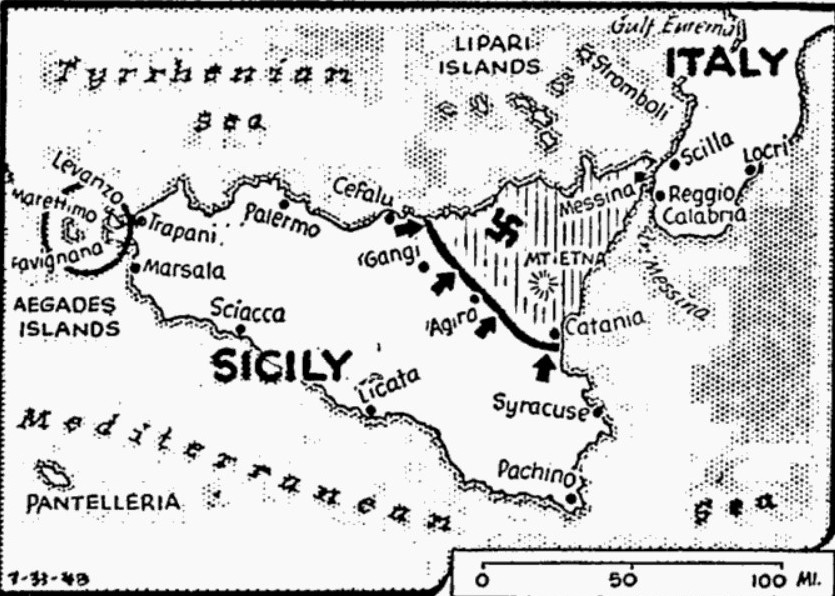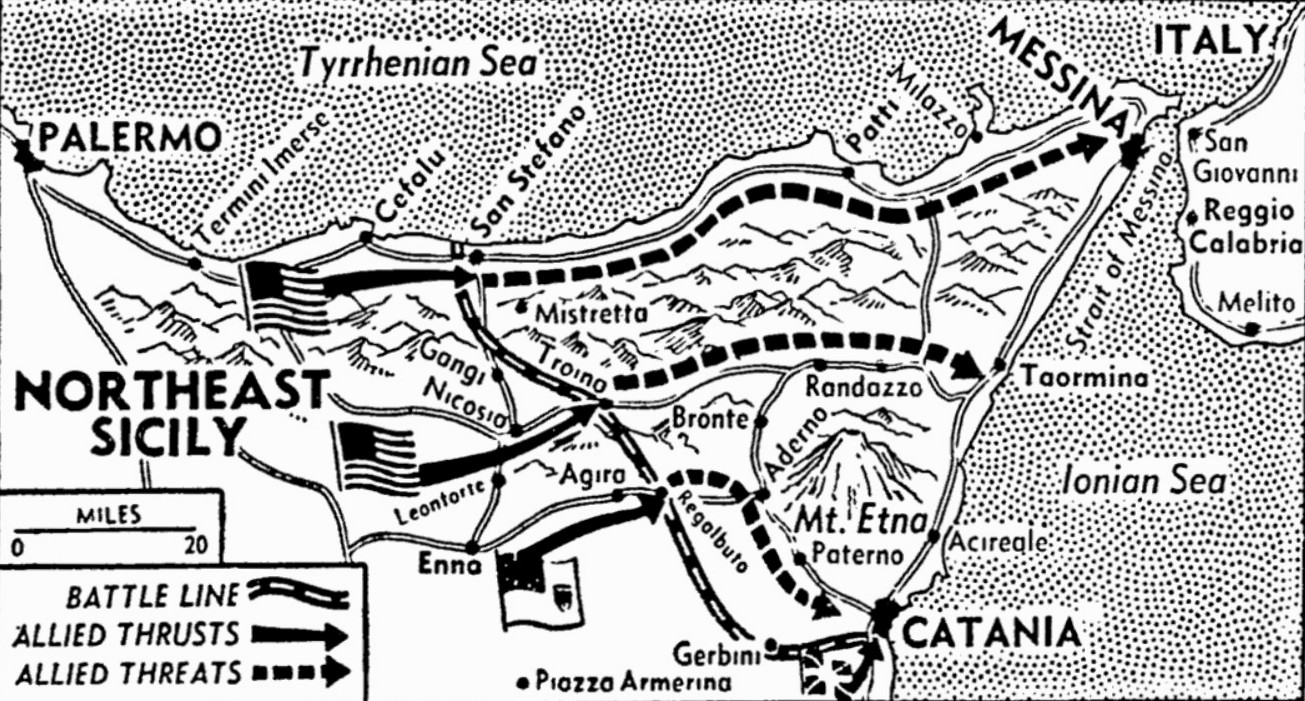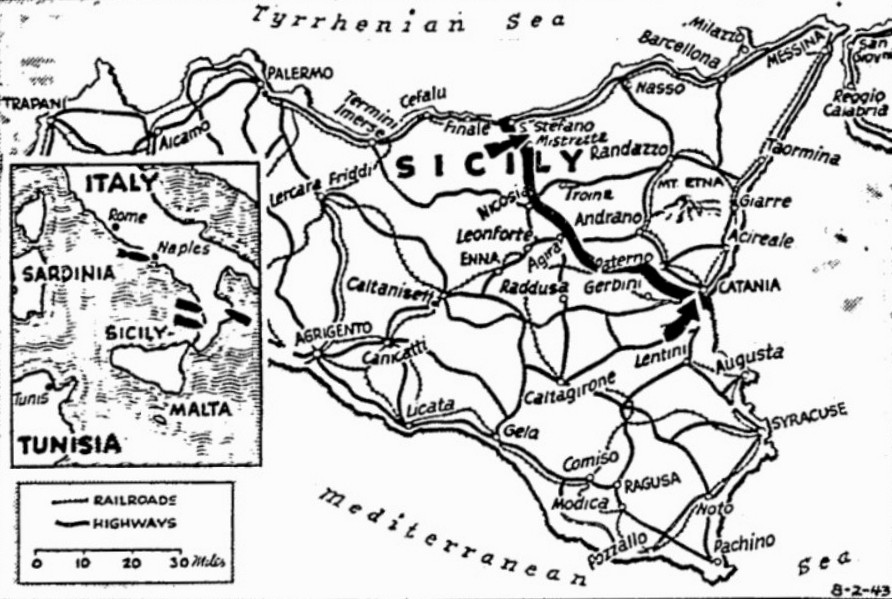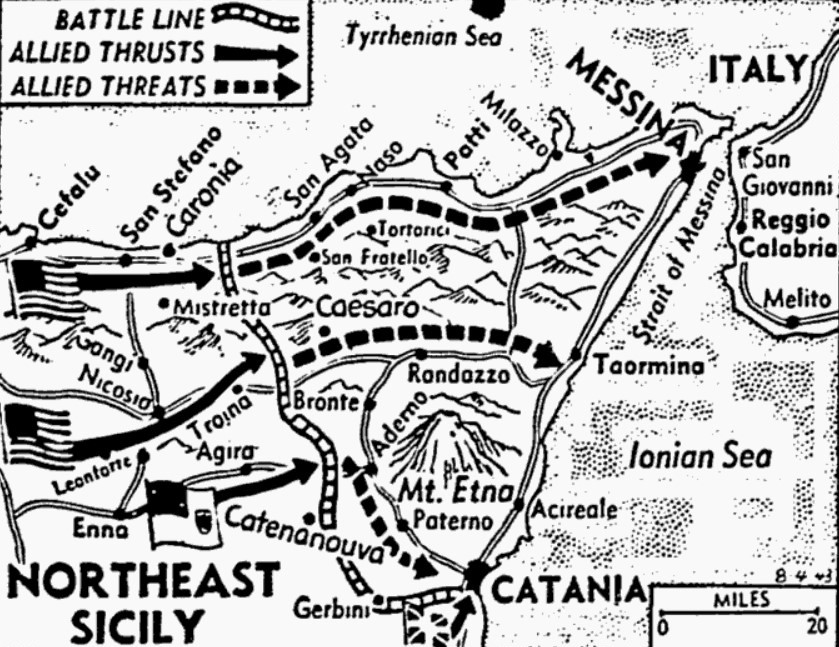The Pittsburgh Press (July 31, 1943)
GREAT AIR ATTACK TO BLAST ITALY
Ships, planes batter Italy; 3 isles seized
Warships shell mainland; fliers attack only 11 miles from Rome
By Virgil Pinkley, United Press staff writer
Surrender of three islands off the west coast of Sicily (circled on the map) was announced today and shelling by warships of the Italian mainland near Locri was also revealed. U.S. PT boats struck at Axis shipping in the Gulf of Eufemia. On land the Allies made more gains and threatened to push Axis forces (now holding the section lined on the map) into a death trap.
Allied HQ, North Africa –
A mounting air and sea offensive that struck faltering Italy within 11 miles of Rome and sent surface craft far up the mainland coast developed today as Allied forces scored steady gains driving Axis troops toward a deathtrap in Sicily.
Three small Italian islands off the Sicilian west coast surrendered unconditionally to U.S. troops.
Headquarters announcements revealed a new bombardment of the mainland near Locri under the toe of the Italian boot, a raid by Mitchell bombers on the Pratica di Mare Airdrome only 11 miles southeast of the capital and thrusts by U.S. PT boats that carried into the Gulf of Santa Eufemia more than 100 miles up the Italian coast above the Strait of Messina.
Allied tightening
With surface vessels slipping within three and four miles of both the Sicilian and Italian mainlands and raiding straight through the strait, the Axis troops falling back in Sicily appeared likely to be caught in an unbreakable Allied net as they were in Tunisia.
Allied planes enjoying mastery of the skies met strong opposition only in sweeps over Sardinia, and there, 21 of the Friday toll of 28 enemy planes were shot down by Warhawks. Additional planes, including big transports, were destroyed on the airfield near Rome. One six-engined transport was sent down. Total Allied loss for the day was one plane, a communiqué said.
Additional progress by land forces in Sicily was revealed in the communiqué. The British 8th Army below Catania inflicted heavy casualties on the defending German forces and the Americans captured 941 additional prisoners, including 500 Germans, in new advances.
A Radio Algiers broadcast said the German and Italian troops in northern and central Sicily were retreating toward a second defense line based in the Caronia Mountains, east of the San Stefano-Nicosia Road.
Aegadian group of islands
The surrendered islands, comprising the Aegadian group, are Favignana, Levanzo and Marettimo. They were the first to surrender since the fall of the stepping stones southward toward the North African shore before the invasion of Sicily.
A Navy communiqué said that a force of cruisers and destroyers shelled railroad bridges near Locri under the toe of the Italian boot about 20 miles above Capo-Spartivento, just opposite the Strait of Messina.
Light naval craft, including U.S. PT boats, struck at Axis communications lines to Sicily by sinking from one to seven enemy ships in the Strait of Messina.
PT boats in battle
The American PT boats ventured as far northward up the Italian mainland to the Gulf of Santa Eufemia, on the instep of the boot, to engage two armed lighters and four enemy “E”-boats, probably destroying one E-boat. Other small war vessels were attacked near Stromboli Island, 70 miles above Sicily.
The delayed reports of the naval action filtered in through front advices covering operations the last five days and included a penetration by British forces so close to Reggio Calabria, Italian ferry base across the strait, that shore batteries fired on the vessels but caused no damage.
No details of the surrender of the islands were given and no attacks had been reported on them. They lie off the end of Sicily now occupied by U.S. troops and the largest, Favignana, is only six miles long.
Second coast shelling
The warships attacked the mainland the night of July 28-29 about 75 miles southwest of the Crotone area which was shelled on July 29.
Eight units from British light coastal forces edged up the Sicilian east coast north of Mt. Etna to bombard railways near Giagargina feeding the German armies facing the British below Catania. The range was so close that machine guns were leveled against them. The shells set fires in stations, trains and stores. The allies ships suffered no damage.
The communiqué on land fighting said both the U.S. 7th Army and the British 8th Army made “good progress” in their operations leading up to a final assault on the enemy’s Mt. Etna line and the “coffin corner” of Sicily.
The prisoners fell to the Americans as they met increased enemy opposition during the push into Axis defense lines anchored on San Stefano, on the north coast, while Canadian troops drove out from the Agira area in the center to drive the Germans back toward Mt. Etna.



